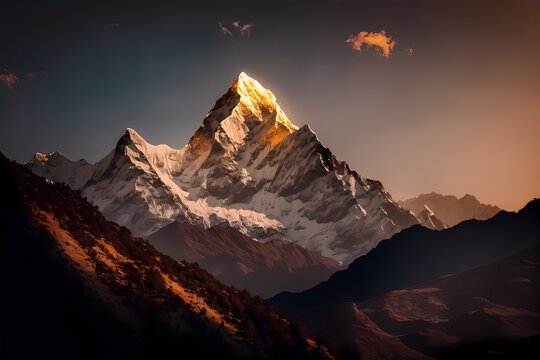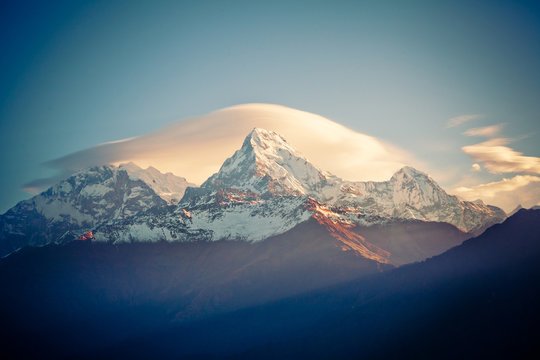01.Introduction to Everest Base Camp Trek
The Everest Base Camp Trek is not merely a physical journey; it is a spiritual odyssey that captures the essence of the Himalayan experience. Beginning in the picturesque town of Lukla, nestled amidst verdant hills and rugged valleys, trekkers embark on a quest that will take them to the very foot of Mount Everest.
The route winds its way through a landscape of unparalleled beauty, passing through quaint Sherpa villages, terraced fields, and dense rhododendron forests ablaze with color. Along the way, trekkers are greeted with warm smiles and hospitality, as they share in the daily rhythms of Sherpa life and culture.

As the trail ascends into the high Himalayas, the air grows thin, and the landscape becomes more rugged and remote. Trekkers traverse suspension bridges spanning deep gorges, ascend steep switchbacks carved into the mountainside, and cross high mountain passes offering panoramic views of snow-capped peaks stretching to the horizon.
At last, after days of trekking through some of the most breathtaking scenery on Earth, trekkers arrive at Everest Base Camp—a sprawling tent city nestled in the shadow of the mighty Everest. Here, amidst the fluttering prayer flags and the icy winds, trekkers stand in awe of the sheer magnitude of the world’s tallest peak, its summit soaring majestically into the sky.
But the journey doesn’t end here. For those seeking an even greater challenge, the trek continues to Kala Patthar—a rocky outcrop offering the best views of Everest’s summit. Here, as the first light of dawn illuminates the snow-capped peaks in a fiery blaze of color, trekkers are rewarded with a sight that will stay with them for a lifetime.
Indeed, the Everest Base Camp Trek is more than just a trek; it is an adventure of the spirit—an opportunity to push oneself to the limits, to connect with nature and with one’s innermost self, and to experience the magic and majesty of the Himalayas in all their glory.
02.Route Description:
The route for the Everest Base Camp Trek is a captivating journey that unfolds over approximately 130 kilometers (80 miles) round trip, leading adventurers through some of the most breathtaking landscapes on Earth. The trek typically begins and ends in the bustling town of Lukla, where trekkers arrive by a short flight from Kathmandu, the capital of Nepal.
From Lukla, the trail meanders through lush green hillsides dotted with traditional Sherpa villages, offering trekkers a glimpse into the unique culture and way of life of the mountain people. Passing through villages such as Phakding and Monjo, trekkers gradually gain altitude as they follow the Dudh Kosi River, its turquoise waters carving a path through the valley below.
Continuing on, the trail ascends steeply to the vibrant Sherpa capital of Namche Bazaar, a bustling market town nestled in a natural amphitheater surrounded by towering peaks. Here, trekkers spend a day acclimatizing to the altitude, exploring the colorful streets lined with tea houses, bakeries, and shops selling traditional handicrafts.

Leaving Namche behind, the trail leads through rhododendron forests ablaze with color in the springtime, crossing high suspension bridges spanning deep river gorges and ascending steep switchbacks carved into the mountainside. Along the way, trekkers pass through picturesque villages such as Tengboche, home to the famous Tengboche Monastery, where they can experience the timeless rituals of Tibetan Buddhism.
As the landscape becomes increasingly rugged and barren, trekkers reach the remote settlement of Dingboche, nestled in a high-altitude valley surrounded by towering peaks. Here, trekkers spend another day acclimatizing to the altitude, with the option to embark on side trips to nearby viewpoints offering panoramic views of the surrounding mountains.
Continuing on, the trail leads through barren moraine landscapes and rocky terrain, ascending steadily towards Everest Base Camp. Passing through villages such as Lobuche and Gorak Shep, trekkers finally reach the desolate expanse of the Everest Base Camp—a sprawling tent city nestled at the foot of the Khumbu Icefall.
For those seeking an even greater challenge, the trek continues to Kala Patthar, a rocky outcrop offering the best views of Everest’s summit. From here, trekkers are treated to a breathtaking panorama of the Himalayas, including Everest, Lhotse, Nuptse, and countless other snow-capped peaks stretching to the horizon.

After soaking in the awe-inspiring views, trekkers retrace their steps back to Lukla, completing the epic journey with memories that will last a lifetime.
03.Distance Covered:
The total distance covered during the Everest Base Camp Trek varies depending on the specific itinerary chosen by trekkers and the side trips taken along the way. However, a typical round trip trek from Lukla to Everest Base Camp and back covers approximately 130 kilometers (80 miles) in total.
a. Lukla to Phakding: The trek begins in Lukla, where trekkers land after a short flight from Kathmandu. From Lukla, the trail descends gently through the Dudh Kosi Valley to the village of Phakding, covering a distance of approximately 8 kilometers (5 miles).
b. Phakding to Namche Bazaar: The trail continues along the banks of the Dudh Kosi River, crossing several suspension bridges and ascending steeply to the vibrant Sherpa capital of Namche Bazaar. This stretch covers approximately 10 kilometers (6 miles) and includes a significant altitude gain.
c. Acclimatization Day in Namche Bazaar: Trekkers spend a day in Namche Bazaar to acclimatize to the altitude, exploring the town and its surroundings. While no significant distance is covered on this day, it is essential for adjusting to the higher elevations.
d. Namche Bazaar to Tengboche: The trek continues through rhododendron forests and picturesque Sherpa villages, ascending gradually to the village of Tengboche. This segment covers approximately 10 kilometers (6 miles) and offers stunning views of Everest and its surrounding peaks.
e. Tengboche to Dingboche: The trail descends to the Imja Khola River before ascending once again to the village of Dingboche. This stretch covers approximately 12 kilometers (7.5 miles) and includes another significant altitude gain.
f. Acclimatization Day in Dingboche: Trekkers spend another day in Dingboche for acclimatization, with the option to take a side trip to nearby viewpoints. While no significant distance is covered on this day, it is crucial for adjusting to the higher altitudes.
g. Dingboche to Lobuche: The trek continues along the moraine of the Khumbu Glacier, ascending gradually to the village of Lobuche. This segment covers approximately 10 kilometers (6 miles) and offers breathtaking views of the surrounding peaks.
h. Lobuche to Gorak Shep and Everest Base Camp: The final stretch of the trek leads to the village of Gorak Shep before continuing to Everest Base Camp. This segment covers approximately 8 kilometers (5 miles) round trip from Lobuche to Gorak Shep and Everest Base Camp.
i. Optional Side Trip to Kala Patthar: For those seeking even more spectacular views, an optional side trip to Kala Patthar offers panoramic vistas of Everest and its surrounding peaks. This additional segment covers approximately 2-3 kilometers (1-2 miles) round trip from Gorak Shep.
j. Return to Lukla: After reaching Everest Base Camp and soaking in the awe-inspiring views, trekkers retrace their steps back to Lukla along the same route, covering approximately 65 kilometers (40 miles) over several days.
So, the total distance covered during the Everest Base Camp Trek is approximately 130 kilometers (80 miles) round trip, with each day’s trek covering varying distances depending on the terrain and altitude gain.
04.Duration of the Trek:
The duration of the Everest Base Camp Trek can vary depending on several factors, including the specific itinerary chosen, the pace of the trekker, and the number of rest/acclimatization days incorporated into the trek. Typically, the trek takes anywhere from 12 to 16 days to complete, including both the trek to Everest Base Camp and the return journey to Lukla.
a.12-Day Itinerary: Some trekking agencies offer a condensed 12-day itinerary for those with limited time or prior trekking experience. This itinerary involves trekking to Everest Base Camp in six to seven days and returning to Lukla in the remaining days. While this option allows trekkers to experience the highlights of the trek in a shorter time frame, it may require longer hours of trekking each day and less time for acclimatization.
b.14-Day Itinerary: The most common itinerary for the Everest Base Camp Trek is the 14-day itinerary, which provides a balance of trekking days and rest/acclimatization days. This itinerary typically includes two acclimatization days—one in Namche Bazaar and one in Dingboche—to help trekkers adjust to the high altitude. Trekkers following this itinerary spend about eight to nine days trekking to Everest Base Camp and the remaining days returning to Lukla.
c.16-Day Itinerary: For those who prefer a more leisurely pace or wish to incorporate additional side trips, a 16-day itinerary may be ideal. This itinerary allows for more time for acclimatization and exploration along the way. Trekkers following this itinerary typically spend about nine to ten days trekking to Everest Base Camp and the remaining days returning to Lukla.
Regardless of the specific itinerary chosen, the duration of the trek also depends on factors such as weather conditions, trail conditions, and individual fitness levels. Trekkers should be prepared for long days of hiking, with daily trekking distances ranging from 5 to 15 kilometers (3 to 9 miles), depending on the terrain and altitude gain.
It’s important for trekkers to listen to their bodies, stay well-hydrated, and take regular breaks to rest and acclimatize to the altitude. Adequate physical conditioning prior to the trek can also help ensure a more enjoyable and successful experience.
05.Altitude Gain:
The Everest Base Camp Trek involves a significant altitude gain as trekkers ascend from Lukla to Everest Base Camp. Starting at Lukla’s elevation of approximately 2,800 meters (9,200 feet), the trek gradually gains altitude as trekkers make their way through the Khumbu Valley to Everest Base Camp, which sits at an elevation of approximately 5,364 meters (17,598 feet).
Throughout the trek, trekkers experience varying degrees of altitude gain, with each day bringing them closer to the towering peaks of the Himalayas. The most significant altitude gains occur during the initial stages of the trek, particularly as trekkers ascend from Lukla to Namche Bazaar and from Namche Bazaar to Tengboche.
Altitude gain is a crucial consideration for trekkers, as rapid ascent can increase the risk of altitude-related illnesses such as altitude sickness. To mitigate these risks, trekkers are advised to ascend gradually, taking rest/acclimatization days to allow their bodies to adjust to the thinning air. Adequate hydration, proper nutrition, and awareness of altitude-related symptoms are also essential for a safe and successful trek to Everest Base Camp.
